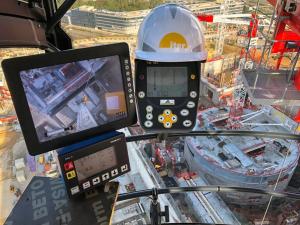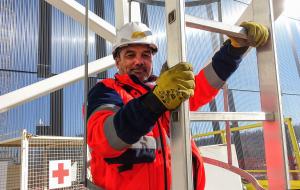A cabin in the sky
Reaching the "office" every day is no easy job. Philippe operates crane #2 (C2), which is 85 metres in height. To access his cabin, he has to climb up a long, thin ladder or take a lift to facilitate his "commute."
Once there, the rules are strict. In most cases—especially the taller cranes—the operator stays in his cabin during the entire shift. Radio is the only means of communication he has with the banksman, combined with a camera, a screen and a joystick. The banksman is fully dressed in orange—the only one on site with this colour—in order to increase his visibility and to facilitate visual contact with the operator in his cabin who is watching his screen closely. The banksman guides the crane operators, helps them complete their works and gives up-to-date information about what might be going on all around.
"Traffic is heavy, just like at an airport, and the five cranes must coordinate and wait for the banksman's green light and instructions before getting started on any operation. He acts as our eyes on the ground and his help is very precious in carrying out our mission successfully and avoiding any danger."
Like pilots, crane operators have the privilege of enjoying breathtaking and ever-changing panoramas. Before working at ITER, Philippe operated a crane at several important building projects in Marseille, including skyscrapers where his cabin was 170 metres above the ground.
The variety of his assignments feeds another one of his passions: amateur photography. He regularly shares the photos he captures from his unique perspective over worksites and cities with friends on social media. "One day I will produce my own photobook to share my unique experiences with the world. I will be proud to say that I have contributed to building the box that will contain a future star on Earth!"



